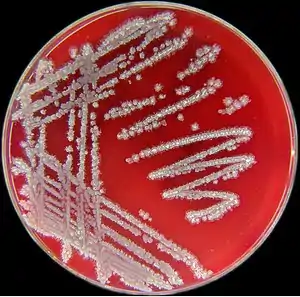Bacillus licheniformis
Bacillus licheniformis ist ein gram-positives, Sporen bildendes Bakterium, das als Saprophyt weite Verbreitung in der Umwelt hat. Die Spezies ist sehr eng mit Bacillus subtilis verwandt. Da sie auch fakultativ anaerob wächst, besetzt die Spezies weitere ökologische Nischen. Sie kommt im Boden vorwiegend als Sporen vor. Einige Isolate sind auch zur Denitrifikation befähigt. Ihre Bedeutung im Stickstoffkreislauf ist jedoch eher gering.[2] Die extrazelluläre, thermostabile, alkalische Protease von B. licheniformis wird industriell beispielsweise als Detergenz in Waschmitteln eingesetzt wie etwa das von B. licheniformis produzierte Subtilisin Carlsberg.[3] Die Keratinase von B. licheniformis wird in der Tierkörperverwertung beim Auflösen von Federn eingesetzt.[4] In der Tiermast von Schweinen und Hühner wird es als Probiotikum dem Futter zugesetzt.[5] Es wird von Toxin produzierenden Stämmen berichtet, die zu Lebensmittelvergiftungen führen können. Diese wurden aus Rohmilch und industriell hergestellter Babynahrung isoliert.[6]
| Bacillus licheniformis | ||||||||||||
|---|---|---|---|---|---|---|---|---|---|---|---|---|

Bacillus licheniformis auf Blutagar | ||||||||||||
| Systematik | ||||||||||||
| ||||||||||||
| Wissenschaftlicher Name | ||||||||||||
| Bacillus licheniformis | ||||||||||||
| (Weigmann 1898) Chester 1901[1] |
Einzelnachweise
- Bacillus licheniformis. doi:10.1601/nm.4935.
- Michael W. Rey, Preethi Ramaiya, Beth A. Nelson, Shari D. Brody-Karpin, Elizabeth J. Zaretsky, Maria Tang, Alfredo Lopez de Leon, Henry Xiang, Veronica Gusti, Ib Groth Clausen, Peter B. Olsen, Michael D. Rasmussen, Jens T. Andersen, Per L. Jørgensen, Thomas S. Larsen, Alexei Sorokin, Alexander Bolotin, Alla Lapidus, Nathalie Galleron, S. Dusko Ehrlich, Randy M. Berka: Complete genome sequence of the industrial bacterium Bacillus licheniformis and comparisons with closely related Bacillusspecies. In: Genome Biology. Band 5, Nr. 10, 2004, ISSN 1474-760X, S. r77, doi:10.1186/gb-2004-5-10-r77, PMID 15461803.
- Stability of thermostable alkaline protease from Bacillus licheniformis RP1 in commercial solid laundry detergent formulations. In: Microbiological Research. Band 163, Nr. 3, 2008, ISSN 0944-5013, S. 299–306, doi:10.1016/j.micres.2006.06.001.
- C. M. Williams, C. S. Richter, J. M. Mackenzie, J. C. Shih: Isolation, identification, and characterization of a feather-degrading bacterium. In: Applied and Environmental Microbiology. Band 56, Nr. 6, 1990, ISSN 0099-2240, S. 1509–1515, doi:10.1128/AEM.56.6.1509-1515.1990, PMID 16348199.
- Chanwit Kaewtapee, Katharina Burbach, Georgina Tomforde, Thomas Hartinger, Amélia Camarinha-Silva, Sonja Heinritz, Jana Seifert, Markus Wiltafsky, Rainer Mosenthin, Pia Rosenfelder-Kuon: Effect of Bacillus subtilis and Bacillus licheniformis supplementation in diets with low- and high-protein content on ileal crude protein and amino acid digestibility and intestinal microbiota composition of growing pigs. In: Journal of Animal Science and Biotechnology. Band 8, Nr. 1, 2017, ISSN 2049-1891, S. 37, doi:10.1186/s40104-017-0168-2, PMID 28469845.
- M. S. Salkinoja-Salonen, R. Vuorio, M. A. Andersson, P. Kämpfer, M. C. Andersson, T. Honkanen-Buzalski, A. C. Scoging: Toxigenic Strains of Bacillus licheniformis Related to Food Poisoning. In: Applied and Environmental Microbiology. Band 65, Nr. 10, 1999, ISSN 0099-2240, S. 4637–4645, doi:10.1128/AEM.65.10.4637-4645.1999, PMID 10508100.